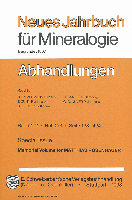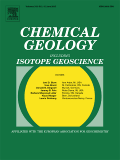
CONTRIBUTIONS TO MINERALOGY AND PETROLOGY
Scope & Guideline
Pioneering Insights in Geochemistry and Petrology
Introduction
Aims and Scopes
- Petrogenesis and Magmatic Processes:
The journal extensively covers the petrogenesis of various rock types, including igneous, metamorphic, and sedimentary. Research often involves studying the formation, evolution, and differentiation processes of magmas, with a focus on the conditions of their generation and ascent. - Fluid-Rock Interactions:
A significant area of research includes the interactions between fluids and rocks, particularly in subduction zones and metamorphic environments. Studies often explore how fluids influence mineral stability, reactions, and the transport of elements during metamorphism. - Experimental Mineralogy and Geochemistry:
The journal publishes experimental studies that simulate natural geological processes, providing insights into mineral behavior under varying temperature, pressure, and chemical conditions. This includes phase equilibria studies, diffusion mechanisms, and thermodynamic modeling. - Isotope Geochemistry:
Research frequently employs isotopic techniques to trace the sources and evolution of magmas, as well as to understand metamorphic processes. This includes U-Pb, Hf, Sr, Nd, and Pb isotopic studies that help elucidate the timing and conditions of geological events. - Mineral Stability and Phase Relations:
The journal emphasizes the stability of minerals and their phase relations in various geological contexts, contributing to the understanding of mineral assemblages and metamorphic pathways.
Trending and Emerging
- High-Pressure and High-Temperature Experiments:
There is an increasing emphasis on high-pressure and high-temperature experimental studies, which aim to replicate the conditions deep within the Earth. This trend is crucial for understanding the behavior of minerals and melts under extreme geological conditions. - Machine Learning Applications:
The application of machine learning and artificial intelligence in mineralogy and petrology is on the rise. Researchers are increasingly using these tools for data analysis, mineral classification, and modeling geological processes. - Volatile Content and Fluid Dynamics:
Recent publications have shown a growing interest in the role of volatiles (e.g., H2O, CO2) in magmatic processes, particularly regarding their influence on magma evolution and eruption dynamics. This theme is essential for understanding volcanic behavior and associated hazards. - Sustainable Resource Exploration:
Research related to the sustainable exploration and utilization of mineral resources, particularly rare earth elements and critical minerals, is becoming more prominent. This reflects a global focus on sustainability and resource management. - Interdisciplinary Approaches:
There is a notable trend toward interdisciplinary research that combines mineralogy and petrology with geophysics, geochemistry, and environmental science. This holistic approach is essential for addressing complex geological questions and challenges.
Declining or Waning
- Traditional Petrology Techniques:
There has been a noticeable decrease in the publication of studies solely relying on traditional petrological techniques without integration of modern analytical methods. Research that lacks comprehensive geochemical or isotopic analyses is becoming less common. - Descriptive Mineralogy without Experimental Context:
Papers that focus exclusively on descriptive mineralogy, such as detailed examinations of mineral properties without linking them to broader geological processes or experimental data, are appearing less frequently. - Single-Phase Studies:
Research focusing on individual mineral phases in isolation is declining. There is a growing preference for studies that integrate multiple phases and their interactions within complex geological systems.
Similar Journals

GEOLOGICA CARPATHICA
Connecting Researchers Through Open Access GeoscienceGEOLOGICA CARPATHICA, with ISSN 1335-0552 and E-ISSN 1336-8052, is a distinguished open access journal published by the Slovak Academy of Sciences Geological Institute, serving as a pivotal platform for the dissemination of research in the field of Geology. Established in 1991 and continuing through 2024, the journal is recognized for its significant contributions to Earth and Planetary Sciences, evidenced by its 2023 Scopus ranking placing it in the second quartile (Q2) within Geology. With an H-index that showcases its impactful publications, GEOLOGICA CARPATHICA is committed to fostering scholarly communication while promoting accessible research, having adopted an open access model since 2009. Located in beautiful Bratislava, Slovakia, this journal aims to engage a global audience of researchers, professionals, and students interested in ecological, geological, and environmental studies, making it a prominent resource for enriching the scientific community's understanding of the Carpathian region and beyond.

NEUES JAHRBUCH FUR MINERALOGIE-ABHANDLUNGEN
Uncovering the secrets of minerals and rocks.NEUES JAHRBUCH FUR MINERALOGIE-ABHANDLUNGEN, published by E Schweizerbart'sche Verlagsbuchhandlung in Germany, is a distinguished scholarly journal dedicated to advancing the fields of mineralogy and petrology. With an ISSN of 0077-7757, it provides a platform for researchers to disseminate high-quality findings that contribute to our understanding of Earth sciences. Although it currently has no open access options, the journal remains vital for professionals seeking to engage with impactful research in geochemistry and petrology, as reflected in its 2023 Scopus ranking in the 21st percentile within its category. The journal has documented significant research from 1980 to 1988 and resumed from 1996 to 2023, making it a crucial archive for historical and contemporary studies. Despite its current Q4 quartile ranking, NEUES JAHRBUCH FUR MINERALOGIE-ABHANDLUNGEN is an important contributor to the academic discourse in its field, and it invites researchers, professionals, and students alike to explore and submit their work that drives innovation and understanding in mineralogical studies.

MINERALOGICAL MAGAZINE
Exploring the Depths of Earth’s CompositionMINERALOGICAL MAGAZINE, published by Cambridge University Press, is a distinguished journal dedicated to advancing the field of mineralogy and its related disciplines, including geochemistry and petrology. With its ISSN 0026-461X and E-ISSN 1471-8022, this quarterly journal has successfully carved a niche since its inception, contributing critical research and insights from 1969, with ongoing publications up to 2024. Holding a commendable Q2 ranking in the field, it currently occupies the 61st position among 154 journals in its category, reflecting its robust influence as measured by Scopus rankings at the 60th percentile. Scholars and researchers seeking to publish impactful findings in earth sciences will find MINERALOGICAL MAGAZINE an essential platform that not only supports rigorous research but also fosters global discourse within the mineralogical community. Its accessibility ensures that valuable insights reach a wide audience, solidifying its position as a beacon for professionals and students alike in understanding the complexities of mineral compositions and their broader implications on earth science.

GEOSCIENCES JOURNAL
Connecting Researchers to Tackle Environmental Challenges.Welcome to the GEOSCIENCES JOURNAL, a pivotal publication in the fields of Earth and Planetary Sciences and Environmental Science, proudly presented by the Geological Society of Korea. Established in 1997, this journal has become a prominent platform for researchers, professionals, and students, offering a rich collection of peer-reviewed articles that explore a diverse array of geoscientific topics. With an impressive Q2 ranking in both Earth and Planetary Sciences and Environmental Science categories for 2023, it stands as an essential resource in the academic community. Though it operates under a traditional subscription model, GEOSCIENCES JOURNAL remains dedicated to advancing knowledge through rigorous research. Addressed from its headquarters in Seoul, South Korea, the journal aims to foster a deeper understanding of geosciences, encouraging innovation and collaboration in tackling today’s environmental challenges.

CHEMICAL GEOLOGY
Bridging Geochemical Research with Real-World ApplicationsChemical Geology is an esteemed international journal published by Elsevier, dedicated to the rigorous exploration of geochemistry and petrology, with its foundational roots tracing back to 1966. As evidenced by its impressive Q1 ranking in both Geochemistry and Petrology as well as Geology in the 2023 category quartiles, this journal stands as a premier outlet for cutting-edge research and innovative methodologies within these vital fields. With a Scopus rank placing it in the top 10% of Earth and Planetary Sciences, Chemical Geology offers a platform for researchers, professionals, and students alike to disseminate findings that advance our understanding of geological processes and materials. Although it does not currently offer open-access options, the journal remains committed to high-quality publications that contribute significantly to the scholarly community. Located in the vibrant academic milieu of Amsterdam, Netherlands, Chemical Geology is an essential resource for those engaged in the earth sciences, aiming to bridge theoretical insights with practical applications.

MINERALIUM DEPOSITA
Fostering Global Dialogue in Geological SciencesMINERALIUM DEPOSITA is a premier journal in the fields of Economic Geology, Geochemistry, and Petrology, published by Springer. With an impressive 2023 impact factor and designated as Q1 in its category, this journal stands out in the academic landscape, showcasing the latest research and developments from 1966 to 2024. With a prominent rank in Scopus, holding the 3rd position in both Geophysics and Geochemistry and Petrology, it represents an invaluable resource for researchers and professionals alike. Although open access options may not be available, the journal's comprehensive coverage of mineral deposits promotes the global exchange of knowledge and advances in our understanding of the geological sciences. Positioned in Germany, MINERALIUM DEPOSITA serves as a crucial platform for innovative discussions, making it essential reading for students, professionals, and academics dedicated to exploring the complexities of earth sciences.

GEOCHEMICAL JOURNAL
Advancing Knowledge in Geochemistry and PetrologyGEOCHEMICAL JOURNAL, published by the Geochemical Society of Japan, stands as a pivotal platform for researchers and professionals dedicated to the fields of geochemistry and petrology, as well as geophysics. With the ISSN 0016-7002 and E-ISSN 1880-5973, this journal has been disseminating cutting-edge research since its inception in 1966 and continues to provide invaluable insights into the complexities of Earth's processes. Currently categorized in the Q3 quartile for both Geochemistry and Petrology and Geophysics, the journal ranks in the 40th and 36th percentiles, respectively, as per Scopus metrics, reflecting its growing influence and relevance in the scientific community. The journal accepts a range of scholarly articles, aiming to foster a deeper understanding of geochemical phenomena while promoting interdisciplinary collaboration among academicians and practitioners. Although not open access, the GEOCHEMICAL JOURNAL's commitment to quality research and education underscores its vital role in advancing the discourse within geoscience.

MINERALOGY AND PETROLOGY
Decoding Earth's Composition Through Rigorous ResearchMINERALOGY AND PETROLOGY, published by Springer Wien, is a premier academic journal that has been contributing to the fields of geochemistry, petrology, and geophysics since its inception in 1987. With an ISSN of 0930-0708 and an E-ISSN of 1438-1168, this journal is recognized for its rigorous peer-reviewed articles that advance the understanding of mineral and rock formation processes, their physical and chemical properties, and the implications for broader Earth sciences. Holding a respectable impact factor and categorized in the Q2 quartile for both Geochemistry and Petrology, as well as Geophysics, MINERALOGY AND PETROLOGY ranks favorably among its peers, placing it within the top 50% of scholarly publications in these fields. Researchers, professionals, and students alike will find a wealth of knowledge in its pages, as it serves as a valuable resource for those aiming to explore the complexities of Earth's materials and compositions. Although it does not offer an Open Access option, the journal assures high-quality, impactful research that is crucial for ongoing advancements in Earth sciences.

LITHOLOGY AND MINERAL RESOURCES
Connecting Science and Sustainability in Mineral ResourcesLITHOLOGY AND MINERAL RESOURCES, published by PLEIADES PUBLISHING INC, is a specialized journal dedicated to advancing knowledge in the fields of economic geology, geochemistry, and petrology. With its ISSN 0024-4902 and E-ISSN 1608-3229, this journal has established itself as a critical resource for scholars and practitioners alike, examining the intricate relationships between lithology and mineral deposits, and their implications for resource management. As indicated by its positioning in the Q3 quartile for both economic geology and geochemistry and petrology in 2023, the journal is recognized for its valuable contributions to the scientific community, ranking #28 out of 43 in Economic Geology and #112 out of 154 in Geochemistry and Petrology according to Scopus. The journal's publication history reveals a rich tradition of excellence, as it has been continuously contributing to the field from 1984 to 2024. While it does not offer open access options, researchers and practitioners can easily engage with its robust body of work in effective ways to support their own studies and applications. The importance of LITHOLOGY AND MINERAL RESOURCES lies in its commitment to publishing high-quality research that informs practices in mineral exploration and environmental stewardship, making it an essential resource for anyone invested in the future of earth sciences.

PRECAMBRIAN RESEARCH
Advancing Earth Sciences Through Precambrian InsightsPRECAMBRIAN RESEARCH is a leading peer-reviewed journal published by Elsevier, dedicated to advancing the field of Earth sciences, with a specific focus on the study of the Precambrian era. With its distinguished Q1 ranking in both Geochemistry and Petrology and Geology, this journal plays a critical role in disseminating high-impact research, thus contributing to its impressive standing, ranked in the top percentages in Scopus for related fields. Founded in 1974, the journal has evolved continually, ensuring comprehensive coverage of geological aspects spanning from geochemical processes to petrological studies. Researchers and students alike will find this journal indispensable for accessing cutting-edge findings, methodologies, and innovative perspectives essential for understanding the Earth’s formative years. Although it does not provide an open-access option, its subscription provides a gateway to a wealth of knowledge and groundbreaking research pivotal for scholarly advancements leading up to 2024.